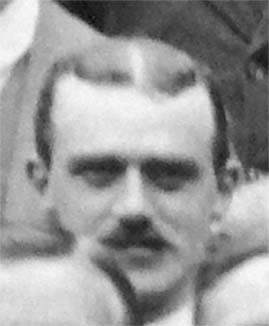
William Barron Coutts
 المؤلف:
J R H Whiston
المؤلف:
J R H Whiston
 المصدر:
W B Coutts, M.A., B.Sc., F.Inst.P., p.a.c., RSE Year Book (1948-1949)
المصدر:
W B Coutts, M.A., B.Sc., F.Inst.P., p.a.c., RSE Year Book (1948-1949)
 الجزء والصفحة:
...
الجزء والصفحة:
...
 19-6-2017
19-6-2017
 1039
1039
Born: 26 May 1885 in Kinghorn, Fife, Scotland
Died: 16 December 1946 in Radcliffe Infirmary, Oxford

William B Coutts' father was Robert Alexander Coutts (born in Kinghorn, Fife about 1857) who was a Bank Accountant. His mother was Elizabeth Martin Barron (born in St Cuthberts, Edinburgh about 1857). He had two younger brothers, Alexander (born about 1888) and Robert (born about 1888).
William B Coutts' home was at Green Croft, Kinghorn. He spent eight years studying at Kirkcaldy High School, sitting the Leaving Certificate examinations in 1903 and 1904. He passed Higher English in June 1903, then Higher Latin, Mathematics, and French in June of the following year.
He first matriculated at Edinburgh University in October 1904. In his first year he took Latin and Mathematics, failing both subjects in April 1905, but passing them in the October resits. His second year was slightly more successful since he passed Natural Philosophy and English at the first attempt in April 1906 but failed Logic and Metaphysics. He sat the examination in Logic and Metaphysics at the resit in October 1906 but, despite improving his performance from 25% to 40%, he failed again. He passed Logic and Metaphysics at the third attempt in April 1907, achieving a comfortable pass at 58%. He also took three attempts to pass Chemistry, failing in July 1907 and April 1908, but passing in July 1908. He took Honours courses in Mathematics, Analytical Dynamics, Thermodynamics, and Advanced Experimental Physics between summer 1906 and 1909, but graduated M.A. without Honours in 1909. He was awarded a B.Sc. (Pure) by the University of Edinburgh in 1912.
After graduating, Coutts taught at George Heriot's School, Edinburgh. However, after World War I began in 1914, Coutts left his teaching position for military service. He was commissioned in 1915 to the Royal Garrison Artillery and served at Gibraltar. The Royal Garrison Artillery dealt with coastal defence, mountain, siege and heavy batteries, and was responsible for ammunition storage and supply.
It was during this period that Coutts became interested in mathematical questions relating to firing. After he left the Royal Garrison Artillery in 1917, he continued in war service until 1918. He then decided not to return to teaching and instead he was a Senior Lecturer, Range-finding and Optics, at the Artillery College, Woolwich. He joined the Staff of the Military College of Science as a Professor in 1919 and worked there until his death in 1946.
He married Isabella Muirhead Allan (Chorlton, Lancashire, 1884-1973).
William Baron Coutts was elected a fellow of the Royal Society of Edinburgh on 1 December 1913. He was proposed for the fellowship by Ralph Allan Sampson, John Brown Clark, Cargill Gilston Knott, and James Robert Milne. His obituary, written by J R H Whiston, appeared in the Royal Society of Edinburgh Year Book (1948-1949), page 12. We give a version below:
W B Coutts, M.A., B.Sc., F.Inst.P., p.a.c.
We regret to record the death on December 16, 1946, at the Radcliffe Infirmary, Oxford, following an operation, of Professor W B Coutts, who served on the Staff of the Military College of Science from 1919 to the date of his death. Born at Kinghorn, Fifeshire, on May 26, 1885, he was educated at Edinburgh University and after a period as a schoolmaster was commissioned in 1915 to the R.G.A. (S.R.). He served at Gibraltar, and it was his work on the Rock which created his lifelong interest in the problems of fire direction and control. In 1917 he was recalled to join the 35th Advanced Class and after completing the course and obtaining the p.a.c. - a distinction of which he was very proud - he was appointed first Instructor and then Senior Lecturer in Range Finding at the College. In 1938 he was promoted to be Assistant Professor of Fire Control Instruments, a position which he held until his death. He was also a member of the Council of the Optical Society and for a period of five years was one of its Honorary Secretaries. He was for many years a regular contributor on Optical Instruments in the Journal of Scientific Instruments.
He was beloved alike by his colleagues and students, to whom he was universally known as "Willie", and his gift of dry Scotch humour enlivened many otherwise dreary conferences and lectures. His specialised knowledge of optical and fire control instruments, and his ability to teach the subjects to technical officers will be a great loss.
J R H Whiston
Coutts joined the Edinburgh Mathematical Society in November 1913. He is one of quite a number who attended the 1913 Edinburgh Mathematical Colloquium held in Edinburgh during the week beginning Monday 4th August 1913, then applied for membership of the Society. After he became a Professor at the Military College of Science, he left the Edinburgh Mathematical Society.
- J R H Whiston, W B Coutts, M.A., B.Sc., F.Inst.P., p.a.c., RSE Year Book (1948-1949), 12.
- First Matriculation 1904-05 (University of Edinburgh).
- in Arts (University of Edinburgh).
 الاكثر قراءة في 1885to1889
الاكثر قراءة في 1885to1889
 اخر الاخبار
اخر الاخبار
اخبار العتبة العباسية المقدسة


